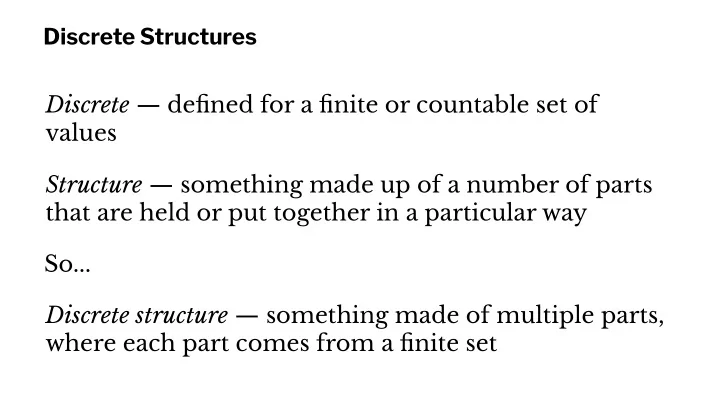

Discrete Structures Discrete — de fi ned for a fi nite or countable set of values Structure — something made up of a number of parts that are held or put together in a particular way So... Discrete structure — something made of multiple parts, where each part comes from a fi nite set
Discrete Structure in Computers — Computers manipulate bits – a fi nite set! – {0,1}. — Anything de fi ned as a sequence of bits is a discrete structure. ( long , int , char , byte , double , etc.) — Anything de fi ned as a collection of these types is a discrete structure. public class Point { int x, y; } — Programs are discrete structures. Finte sets = language keywords, primitive types, etc.
Discrete Structure in Computers — Computers are layers upon layers of discrete structures. — Need more experience reasoning about things de fi ned this way.
This class — Practice thinking about & manipulating discrete structures. — Computer science topics: numeric representation, combinational circuits, fi nite automata. — Discrete mathematics topics: sets, logic and proof, functions and relations, sequences and recursion, counting techniques. — Goal: develop language, notation, basic concepts.
Example: Interpreting binary numeric data Most data processed by computers is numeric. If we have 32 bits and want to interpret numerically. the three most common ways to do so are - unsigned int (C/C++): Only non-negative integers - int : Allows negative integers - float : Real numbers
Example: Unsigned integers When you fi rst learned about binary... Each bit position has a power-of-two place value.
Example: Signed integers To get negative values, make most signi fi cant bit place value negative . This representation is called 32-bit two's complement . (Must say number of bits to know which bit is negtive.)
Example: Two's complement Java byte is 8-bit two's complement. Given 11001010 what's it's value interpreted as a byte ? Letting , then the value Range: 10000000 ... 01111111 = -128 ... 127.
Example: 32-bit IEEE-754 Floating Point Like scienti fi c notation: sign, exponent, signi fi cand. Let (sign bit) interpreted excess-127 (exponent) as a fi xed point fraction (signi fi cand)
Excess notation A less common way to represent negative integers. — Interpret the bits as an unsigned integer. — Subtract the "excess". Exmaple: 11001010 in excess-127. 11001010 is 202 as an unsigned integer. Subtract 127 yields 75.
Fixed point fraction — In decimal numbers, numbers right of decimal point have place values , , , etc. — The same can be done in binary. Numbers right of decimal point have place values , , , etc. — Bits for should be interpreted like fractional part. 10011 ==> 1/2 + 1/16 + 1/32 ==> .
Recommend
More recommend